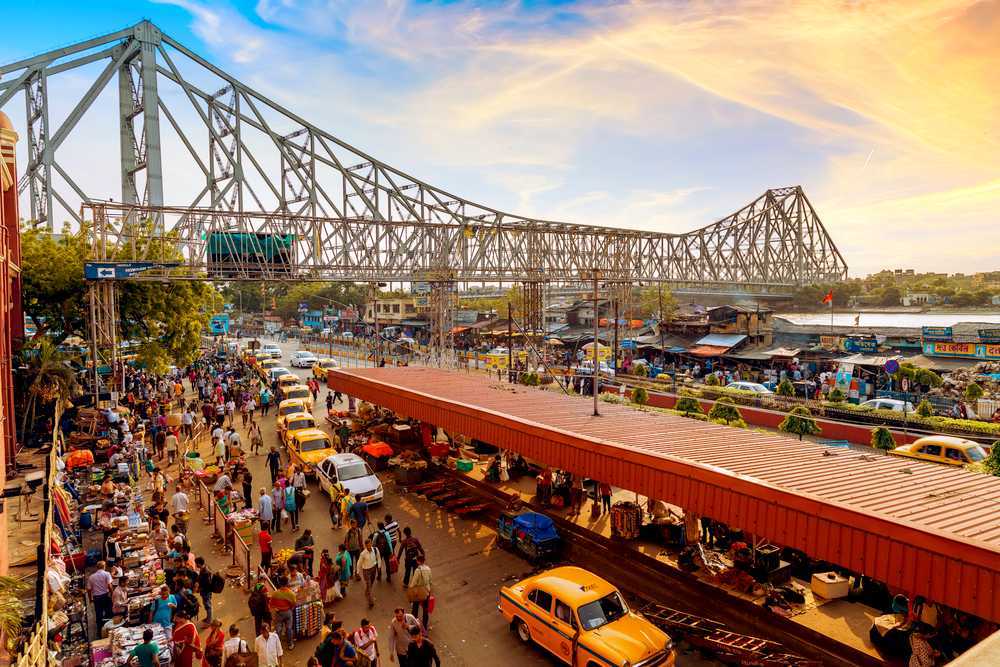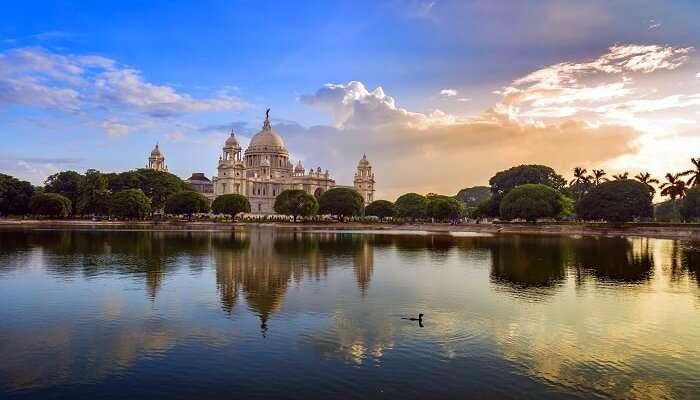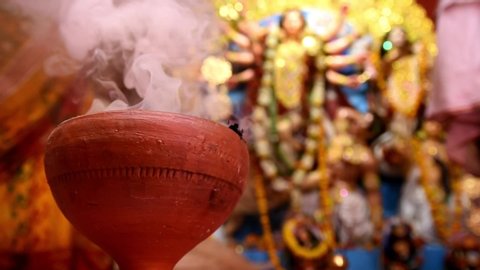
This is the Howrah Bridge (in Kolkata) viewed from a departing airplane at midnight. If one stretches their imagination a little, one will notice that the bent shape of the Howrah Bridge resembles a subtle smile. She is smiling back at you as you leave the city for another city. She wishes you the very best for your future.
However, secretly, She also knows for a fact that no matter how modern and flashy other cities are, they won't be a city with a 'heart'. The reason why Kolkata is called the "City of Joy" is because Kolkata is a city with a heart, with a soul.
Here is my city in pictures. I have tried to uphold the essence of Kolkata, which always refuses to give up its originality and integrity in the face of surmounting pressure.
1. Howrah Bridge (obscurely known as Rabindra Setu) is built on the Ganga river. It was imagined by George Turnbull in 1935 and opened in 1943. It is currently the sixth-longest cantilever bridge in the world. On the left side of the bridge is one of the busiest railway stations in the world- the Howrah Railway Station. Do you notice the iconic yellow taxis? As of now, it only operates in Kolkata.
2. Victoria Memorial: Following the orders of Lord Curzon in 1901, the monument was constructed to honor Queen Victoria. It was opened in 1921 and remains the largest monument dedicated to any monarch across the world.
P.S. Before entering, do buy a pack of the peanut-onion-chilli mixture from the seller just outside its gate. You won't regret it. Oh, and also carry your best camera or DSLR. If weather permits, you will surely return with some amazing clicks!
3. MG road or Mahatma Gandhi Road. If you ask me, this has got to be the most chaotic road in the whole world! But despite all chaos, everything somehow works. It connects important places like College Street, Presidency University, Sealdah Station, and Hatibagan. The Barra-bazaar is located here and is a huge flea market exploited by wholesalers across North India.

4. Esplanade / New Market: A famous open-air shopping market in Kolkata where one can experience the harmonious co-existence of rich and poor brands, pretentious and un-pretentious crowd, and lastly, tasty and extremely tasty food! Eateries that I would recommend are - Nizam's, Hogg's room, and Chittoda's Suruchee Restaurant. Kolkata made it to the list of 11 best food destinations (9th position) in the world as being the only Indian city. To know more follow this link: https://www.eater.com/maps/best-restaurants-kolkata-calcutta-india-bengal
5. This is called the "Biswa-Bangla Gate" which is actually a rotating restaurant overlooking the modern part of Kolkata- Newtown. This region constitutes the IT hub of the city, surrounded by tall buildings and complex architecture. It also boasts a 480-acre-Urban park, a wax museum, and some posh hotels.

6. Durga Puja: This is the grandest festival of Bengalis. Around this time, Kolkata suddenly attains an unmeasurable aura of magic and jolliness. Themed pandals are constructed to commemorate the victory of Goddess Durga over Mahishasur. People celebrate by visiting different pandals with family and friends, mostly eating outside during the four days of festivities and in general having a gala time. Busiest of professionals will adjust their schedules, non-residents will make time, school kids will pre-finish their homework, lovers will pre-plan outings, and, lastly scattered families unite just to visit Kolkata during this time. Even miles away, Durga Puja is celebrated by NRIs.
7. Great personalities: In case you stumbled upon these famous names, they were from Kolkata or were closely associated with the city...(By no means this list is exhaustive. It is impossible to list all the famous personalities in a single post.) I will keep complementing it from time to time.
Swami Vivekananda. He was an Indian Hindu monk, philosopher, author, religious teacher, and the chief disciple of the Indian mystic Ramakrishna. He was a key figure in introducing Hinduism and Yoga to the western world. After his famous speech in the American parliament in Chicago in 1893, the American newspapers described him as, “an orator by divine right and undoubtedly the greatest figure at the Parliament”.
 Rabindranath Tagore
Rabindranath Tagore. Nobel Prize in Literature 1913 for
Gitanjali ( Song Offerings). He was also the first non-European to receive this prize. His works celebrate the complexities of human relationships and the beauty of the simplicity of life and nature.
Satyendra Nath Bose. The founder of Bose statistics and Bosons (half of the fundamental particles in the standard model) is named after him. He proved the Planck Radiation formula without any ad-hoc assumptions or classical theory but using only pure mathematics. He closely collaborated with Albert Einstein and developed the theory of Bose-Einstein Condensate.
Jagadish Chandra Bose. He was a biologist, physicist, and botanist. A pioneer in microwave optic research and the inventor of the crescograph. A crater on the moon was named in his honor.
Sarat Chandra Chattopadhyay. He was a Bengali novelist and short story writer of the early 20th century. Notable works:
Srikanta, Choritrohin, Devdas, Parineeta, and Pother Dabi. His works have been translated into several Indian languages and also adapted into movies (
Parineeta and
Devdas).
Ashok Sen. Indian theoretical physicist. He is the winner of the Fundamental prize in Physics (2012) for his groundbreaking work on string theory and a Fellow of the Royal Society (1998, nominated by
Stephen Hawking), Dirac Medal (2014), ICTP prize (1989), Padma Shri (2001) and loads of other accolades.
Amal Kumar Raychaudhuri. He was an Indian physicist, known for his research in general relativity and cosmology. Not at all well known even in our country but some of his theorems have earned noble prizes in black hole astrophysics such as Stephen Hawking's and Roger Penrose's (to read further: see Penrose–Hawking singularity theorems). He is famous for formulating a method to handle singularities in the general theory of relativity (GTR) and ultimately showing that singularities are an artefact of GTR (the Raychaudhuri Equation or Raychaudhuri-Landau Equation). He shares credit with Lev Landau.

C. V. Raman. Indian physicist was known for his work in the field of light scattering. Originally from Tamil Nadu, he was posted as an Assistant Accountant General in Calcutta (now Kolkata). Later he took up the prestigious Palit Chair of Physics position at the Calcutta University. It was at the Indian Association of Cultivation of Science (in Kolkata), Raman and his research group discovered the Raman Effect (Feb. 1928). He received the noble prize in physics in 1930 for that discovery. This made him the first Asian to receive the honor in any field of science. He was also inducted into the Royal Society ( 1924) but 40 years later he resigned.
Satyajit Ray: Indian director, screenwriter, documentary filmmaker, author, essayist, lyricist, magazine editor, illustrator, calligrapher, and music composer. Some of his most famous works are Pather Panchali, Apu Trilogy and Charulata. He is also the creator of the famous detective character- Feluda. He received the Padma Shri in 1958, an honourary Academy Award in 1992 and the Legion of Honor in 1987. Many celebrated directors like Martin Scorsese, Francis Ford Coppola, Akira Kurosawa and Chris Nolan have praised his work and claimed to have also been inspired by Ray.


 Rabindranath Tagore. Nobel Prize in Literature 1913 for Gitanjali ( Song Offerings). He was also the first non-European to receive this prize. His works celebrate the complexities of human relationships and the beauty of the simplicity of life and nature.
Rabindranath Tagore. Nobel Prize in Literature 1913 for Gitanjali ( Song Offerings). He was also the first non-European to receive this prize. His works celebrate the complexities of human relationships and the beauty of the simplicity of life and nature.












